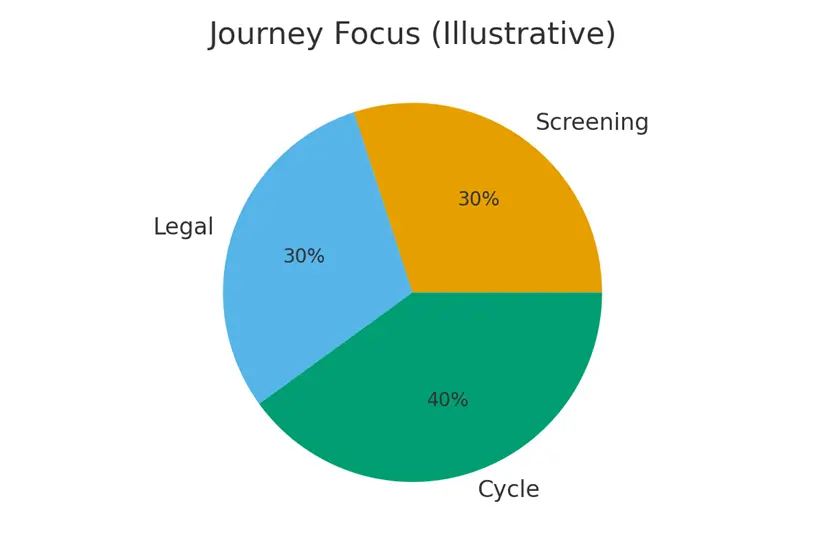
This article explains fresh vs frozen donor eggs — success, timing, cost within the Donor Options (Eggs vs Embryos vs Sperm) pathway. We focus on practical choices that shape outcomes, budgets, and timelines—so you can move forward with confidence.
What It Is
Fresh vs Frozen Donor Eggs — Success, Timing, Cost in plain English: a comparison of how each option works, where it fits in treatment, what it changes in IVF workflows, and how early decisions influence downstream results like embryo numbers, scheduling, and financial planning.
Who It Helps
This guidance supports:
- Individuals/couples with diminished ovarian reserve or recurrent IVF failures
- Single parents by choice and same-sex couples
- Anyone deciding between guaranteed frozen-egg cohorts vs potentially higher-yield fresh cycles
- Patients balancing age, medical history, ovarian reserve testing, and long-term family goals
It also outlines signals that suggest a good fit—and when to consider alternate paths such as donor embryos or frozen embryo banks.
Step-by-Step
A simplified sequence with timing checkpoints designed to protect embryo quality and reduce stress:
- Consultation & medical review
- Choosing fresh vs frozen donor pathway
- Legal, financial, and screening clearance
- Cycle timing — synchronization for fresh vs immediate access for frozen
- Retrieval (fresh) or thaw (frozen) + fertilization
- Embryo growth, PGT decisions, and grading
- Transfer planning or embryo storage
- Post-cycle review and next-step planning
Pros & Cons
Fresh Donor Eggs
Pros
- Higher egg yield potential
- More embryos, often better for future siblings
- Donor monitored in real time
Cons
- Longer timeline due to synchronization
- Higher overall cost
- Egg yield not guaranteed
Frozen Donor Eggs
Pros
- Ready immediately, faster path to transfer
- Predictable cost structure
- No scheduling with donor required
Cons
- Smaller egg batches
- Fewer embryos on average
- Thaw survival rates vary by clinic
Balanced expectations help match each option to your goals.
Costs & Logistics
A transparent overview of:
- Donor compensation (fresh only)
- Egg bank fees (frozen)
- Retrieval, monitoring, medication, and lab charges
- Legal agreements and agency fees
- PGT, storage, and transfer costs
Also included: prior authorizations, how to pace expenses, and simple tracking systems to prevent surprise bills and cash-flow stress.
What Improves Outcomes
Evidence-based actions with real impact:
- Clinics with strong lab experience in frozen-egg thawing
- Selecting donors with proven ovarian reserve indicators
- Using ICSI for frozen eggs
- Realistic embryo-number planning based on family size goals
Also noted: actions that rarely change outcomes, like excessive donor filtering or extra non-medical testing.
Case Study
A couple is unsure whether a fresh cycle (more embryos) or frozen eggs (faster timeline) is right for them. Through structured communication, egg-yield expectations, budget limits, and defined thresholds for embryo numbers, they select a plan that meets both their timing needs and long-term family-building goals.
Mistakes to Avoid
Common traps and how to prevent them:
- Assuming frozen eggs perform exactly like fresh eggs
- Choosing fresh cycles without factoring in donor scheduling delays
- Overestimating embryo yield from frozen cohorts
- Starting treatment without finalized legal or financial clearance
- Failing to plan for future sibling needs
Checklists and upfront planning help avoid preventable stress.
FAQs
Q. Are fresh donor eggs more successful than frozen?
Ans. Fresh eggs generally result in more embryos because they come from a single retrieval, but frozen eggs can achieve similar pregnancy rates in experienced labs.
Q. How many frozen eggs equal one fresh cycle?
Ans. A typical frozen batch may include 6–8 eggs, whereas a fresh cycle may produce 12–20 eggs depending on the donor. This affects embryo numbers and planning for siblings.
Q. Is the thaw survival rate guaranteed for frozen eggs?
Ans. Not fully. Survival depends on the egg bank’s vitrification method and the clinic’s thaw expertise.
Q. Is timing faster with frozen eggs?
Ans. Yes. Frozen eggs are available immediately, while fresh cycles require donor–recipient synchronization and can take several weeks to months.
Q. Which option is better for future siblings?
Ans. Fresh cycles usually provide more embryos, offering better chances of genetic siblings, while frozen batches may only yield 1–2 embryos.
Next Steps
- Free 15-min nurse consult
- Upload your labs
- Get a personalized cost breakdown for your case
Related Links

Dr. Kulsoom Baloch
Dr. Kulsoom Baloch is a dedicated donor coordinator at Egg Donors, leveraging her extensive background in medicine and public health. She holds an MBBS from Ziauddin University, Pakistan, and an MPH from Hofstra University, New York. With three years of clinical experience at prominent hospitals in Karachi, Pakistan, Dr. Baloch has honed her skills in patient care and medical research.





